Experimental Investigation of Frost Formation Influence on an Air Source Heat Pump Evaporator
Abstract
:1. Introduction
2. Methodology of Investigation
- –
- data logger Almemo 2890-9 for air parameters storing;
- –
- an IRIS-type flow control diaphragm with measuring nozzles. The diaphragm contains a differential pressure sensor FD A602-S1K with a measuring range of +/−1250 Pa and an RH accuracy of ±2.0% RH in the range <90% at a nominal temperature (25 °C ± 3 K) [33]. The air flow rate was evaluated knowing the measured pressure difference;
- –
- temperature and relative humidity (RH) sensor FHA 646 series E1 with pressure accuracy of ±0.5% of the final value in the range of 0 to the positive final value at a nominal temperature (25 °C) [34];
- –
- data logger HOBO U30 USB for the climate data storage station [35] and measurement with temperature and RH sensor S-THB-M002 [36]. The measuring range of temperature is from −40 °C to 75 °C, and the RH is 0–100%. The accuracy of air temperature is ±0.21 °C from 0 °C to 50 °C and RH, ±2.5% from 10% to 90% RH (typical), up to a maximum of +/−3.5% including hysteresis at 25 °C; below 10% and above 90% ±5% typical;
- –
- energy data logger HOBO H22 for storing water temperature and flow parameters [37];
- –
- 12-bit smart temperature sensor S-TMB-M017 with a measuring range of 40° to 100 °C and accuracy < ±0.2 °C from 0 °C to 50 °C [38];
- –
- water flow meter sensor T-MINOL-130-NL with a measuring range of 0.95 l/min to 83.3 l/min and accuracy AWWA (American Water Works Association) spec 97–103% [39];
- –
- multi-meter/data-logger EX542 for electric current measurement and data storage, accuracy: ±0.06% [40];
- –
- leakage clamp TRMS meter with power functions MD9272 for power factor measurement with a measuring range of 0 to 1.00, accuracy: ±5 digits [41];
- –
- a digital clock.
- positive average ambient temperature (~4 °C) and average relative humidity (~86%);
- negative ambient temperature (from −7 to −1 °C, about −3 °C) and average relative humidity (~93%);
- average temperature about (0 °C) and average relative humidity (~95%).
3. Results and Discussion
- –
- from 5 p.m. on November 11 to 1 p.m. on November 12;
- –
- from 5 p.m. on December 1 to 2 p.m. on December 3;
- –
- from 4 p.m. on December 15 to 1 p.m. on December 17.
4. Conclusions
- Frost formation on the evaporator’s heat exchanger plates started when the outdoor air temperature was below 3.5 °C, and the relative humidity reached 88%;
- The frozen evaporator’s defrost cycle took an average of 5 min. The defrost cycle remained the same during the different experiments, regardless of the ambient air parameters, and only its frequency varied:
- –
- 0.52 times per hour with an average ambient temperature of 4.02 °C, and average relative humidity of 85.75%;
- –
- once per hour, when the average ambient air temperature was −2.80 °C, and average relative humidity was 92.54%;
- –
- 1.17 times per hour with an average ambient temperature of 0.51 °C, and average relative humidity of 94.90%.
- The specific HP COP values and their reduction in the case of evaporator freezing were assessed in detail based on the ASHP performance data. The frost and defrost process alone reduced the COP by 10.74% compared to the same period as the evaporator froze, but the defrost process did not occur. In other cases (at lower outdoor temperatures and high relative humidity), the COP fell even further (by up to 20.99% when the average ambient air temperature was −2.80 °C). It was confirmed that the freezing of the heat exchanger and the frosting of its surface impairs heat transfer to and from the environment, disrupting the normal operating cycle of the heat pump;
- During the experiments, the dependence of the extracted air flow on the ambient air temperature was observed. The average air flow rate was found to decrease as the ambient temperature rose. This indicates that at higher air temperatures, a lower air flow is required to ensure the same heat carrier parameters.
Author Contributions
Funding
Institutional Review Board Statement
Informed Consent Statement
Data Availability Statement
Conflicts of Interest
References
- Wei, W.; Skye, H.M. Residential net-zero energy buildings: Review and perspective. Renew. Sustain. Energy Rev. 2021, 142, 110859. [Google Scholar] [CrossRef]
- Hewitt, D.; Coakley, S. Transforming our buildings for a low-carbon era: Five key strategies. Electr. J. 2019, 32, 106624. [Google Scholar] [CrossRef]
- Paiho, S.; Pulakka, S.; Knuuti, A. Life-cycle cost analyses of heat pump concepts for Finnish new nearly zero energy residential buildings. Energy Build. 2017, 150, 396–402. [Google Scholar] [CrossRef]
- Wang, F.; Zhao, R.; Xu, W.; Huang, D.; Qu, Z. A heater-assisted air source heat pump air conditioner to improve thermal comfort with frost-retarded heating and heat-uninterrupted defrosting. Energies 2021, 14, 2646. [Google Scholar] [CrossRef]
- Li, Z.; Wang, W.; Sun, Y.; Wang, S.; Deng, S.; Lin, Y. Applying image recognition to frost built-up detection in air source heat pumps. Energy 2021, 233, 121004. [Google Scholar] [CrossRef]
- Zhang, Y.; Zhang, G.; Zhang, A.; Jin, Y.; Ru, R.; Tian, M. Frosting phenomenon and frost-free technology of outdoor air heat exchanger for an air-source heat pump system in China: An analysis and review. Energies 2018, 11, 2642. [Google Scholar] [CrossRef] [Green Version]
- Song, M.; Deng, S.; Dang, C.; Mao, N.; Wang, Z. Review on improvement for air source heat pump units during frosting and defrosting. Appl. Energy 2018, 211, 1150–1170. [Google Scholar] [CrossRef]
- Kropas, T.; Streckienė, G. Orinio šilumos siurblio šilumokaičio užšalimo mažinimo ir valdymo būdai. In Proceedings of the 23th Conference for Junior Researchers “Science—Future of Lithuanuania”, Vilnius, Lithuania, 15 May 2020; pp. 1–7. [Google Scholar]
- Heu, C.S.; Jang, H.; Jeon, J.; Lee, K.S.; Rip Kim, D. Recent progress on developing anti-frosting and anti-fouling functional surfaces for air source heat pumps. Energy Build. 2020, 223, 110139. [Google Scholar] [CrossRef]
- Su, W.; Li, W.; Sun, B.; Zhang, X. Experimental study and correlations for heat and mass transfer coefficients in the dehumidifier of a frost-free heat pump system. Int. J. Heat Mass Transf. 2019, 131, 450–462. [Google Scholar] [CrossRef]
- Liu, Z.; Fan, P.; Wang, Q.; Chi, Y.; Zhao, Z.; Chi, Y. Air source heat pump with water heater based on a bypass-cycle defrosting system using compressor casing thermal storage. Appl. Therm. Eng. 2018, 128, 1420–1429. [Google Scholar] [CrossRef]
- Wang, X.; Xia, L.; Bales, C.; Zhang, X.; Copertaro, B.; Pan, S.; Wu, J. A systematic review of recent air source heat pump (ASHP) systems assisted by solar thermal, photovoltaic and photovoltaic/thermal sources. Renew. Energy 2020, 146, 2472–2487. [Google Scholar] [CrossRef] [Green Version]
- Wang, F.; Liang, C.; Zhang, X. Research of anti-frosting technology in refrigeration and air conditioning fields: A review. Renew. Sustain. Energy Rev. 2018, 81, 707–722. [Google Scholar] [CrossRef]
- Guo, X.M.; Chen, Y.G.; Wang, W.H.; Chen, C.Z. Experimental study on frost growth and dynamic performance of air source heat pump system. Appl. Therm. Eng. 2008, 28, 2267–2278. [Google Scholar] [CrossRef]
- Chung, Y.; Yoo, J.W.; Kim, G.T.; Kim, M.S. Prediction of the frost growth and performance change of air source heat pump system under various frosting conditions. Appl. Therm. Eng. 2019, 147, 410–420. [Google Scholar] [CrossRef]
- Liang, C.; Wang, F.; Lü, Y.; Wu, C.; Zhang, X.; Zhang, Y. Experimental study of the effects of fin surface characteristics on defrosting behavior. Appl. Therm. Eng. 2015, 75, 86–92. [Google Scholar] [CrossRef]
- Carroll, P.; Chesser, M.; Lyons, P. Air Source Heat Pumps field studies: A systematic literature review. Renew. Sustain. Energy Rev. 2020, 134, 110275. [Google Scholar] [CrossRef]
- Mendoza-Miranda, J.M.; Mota-Babiloni, A.; Ramírez-Minguela, J.J.; Muñoz-Carpio, V.D.; Carrera-Rodríguez, M.; Navarro-Esbrí, J.; Salazar-Hernández, C. Comparative evaluation of R1234yf, R1234ze(E) and R450A as alternatives to R134a in a variable speed reciprocating compressor. Energy 2016, 114, 753–766. [Google Scholar] [CrossRef]
- Le, K.X.; Huang, M.J.; Shah, N.; Wilson, C.; Artain, P.M.; Byrne, R.; Hewitt, N.J. High temperature air source heat pump coupled with thermal energy storage: Comparative performances and retrofit analysis. Energy Procedia 2019, 158, 3878–3885. [Google Scholar] [CrossRef]
- Eom, Y.H.; Chung, Y.; Park, M.; Hong, S.B.; Kim, M.S. Deep learning-based prediction method on performance change of air source heat pump system under frosting conditions. Energy 2021, 228, 120542. [Google Scholar] [CrossRef]
- Li, Y.; Li, W.; Liu, Z.; Lu, J.; Zeng, L.; Yang, L.; Xie, L. Theoretical and numerical study on performance of the air-source heat pump system in Tibet. Renew. Energy 2017, 114, 489–501. [Google Scholar] [CrossRef]
- Wei, W.; Wang, B.; Gu, H.; Ni, L.; Yao, Y. Investigation on the regulating methods of air source heat pump system used for district heating: Considering the energy loss caused by frosting and on–off. Energy Build. 2021, 235, 110731. [Google Scholar] [CrossRef]
- Wang, W.; Feng, Y.C.; Zhu, J.H.; Li, L.T.; Guo, Q.C.; Lu, W.P. Performances of air source heat pump system for a kind of mal-defrost phenomenon appearing in moderate climate conditions. Appl. Energy 2013, 112, 1138–1145. [Google Scholar] [CrossRef]
- Pu, J.; Shen, C.; Zhang, C.; Liu, X. A semi-experimental method for evaluating frosting performance of air source heat pumps. Renew. Energy 2021, 173, 913–925. [Google Scholar] [CrossRef]
- Wang, Z.; Song, M.; Wang, F.; Ma, Z.; Lin, Q. Experimental investigation and seasonal performance assessment of a frost-free ASHP system with radiant floor heating. Energy Build. 2018, 179, 200–212. [Google Scholar] [CrossRef]
- Januševičius, K.; Bielskus, J.; Martinaitis, V.; Streckienė, G.; Rimdžius, D. Expressing the building energy systems thermodynamic seasonal efficiency. 10th Int. Conf. Environ. Eng. ICEE 2017 2017, 27–28. [Google Scholar] [CrossRef]
- Cao, C.; Li, H.; Feng, G.; Zhang, R.; Huang, K. Research on PV/T—Air Source Heat Pump Integrated Heating System in Severe Cold Region. Procedia Eng. 2016, 146, 410–414. [Google Scholar] [CrossRef] [Green Version]
- Wang, Z.; Wang, F.; Ma, Z.; Lin, W.; Ren, H. Investigation on the feasibility and performance of transcritical CO2 heat pump integrated with thermal energy storage for space heating. Renew. Energy 2019, 134, 496–508. [Google Scholar] [CrossRef]
- Vocale, P.; Morini, G.L.; Spiga, M. Influence of outdoor air conditions on the air source heat pumps performance. Energy Procedia 2014, 45, 653–662. [Google Scholar] [CrossRef] [Green Version]
- Januševičius, K.; Streckienė, G. Analysis of air-to-water heat pump in cold climate: Comparison between experiment and simulation. Moksl.—Liet. Ateitis 2015, 7, 468–474. [Google Scholar] [CrossRef] [Green Version]
- Yao, Y.; Jiang, Y.; Deng, S.; Ma, Z. A study on the performance of the airside heat exchanger under frosting in an air source heat pump water heater/chiller unit. Int. J. Heat Mass Transf. 2004, 47, 3745–3756. [Google Scholar] [CrossRef]
- Zhu, J.H.; Sun, Y.Y.; Wang, W.; Deng, S.M.; Ge, Y.J.; Li, L.T. Developing a new frosting map to guide defrosting control for air-source heat pump units. Appl. Therm. Eng. 2015, 90, 782–791. [Google Scholar] [CrossRef]
- Differential Pressure and Pitot Tube Measurement Measuring Connector FDA 602 S1K/S6K. 2021. Available online: https://www.ahlborn.com/download/katalog/en/AhlbornCat20e.pdf (accessed on 10 September 2021).
- Protective Caps for Capacitive Humidity Sensors FHA 646 E1. Available online: http://www.belmet.si/Custom/Modules/Products/uploadedFiles/Products/Datoteke/AMR%20kapacitivna%20sonda%203-FY763.pdf (accessed on 10 September 2021).
- HOBO U30 USB Weather Station Data Logger. Available online: https://www.onsetcomp.com/products/data-loggers/u30-nrc/ (accessed on 9 September 2021).
- HOBO S-THB-M002 Sensor. Available online: https://www.onsetcomp.com/datasheet/S-THB-M002 (accessed on 15 August 2021).
- HOBO H22 Energy Data Logger. Available online: https://www.onsetcomp.com/products/data-loggers/h22-001/ (accessed on 14 August 2021).
- Onset. 12-Bit Temperature Smart Sensor (S-TMB-M017). Available online: https://www.onsetcomp.com/products/sensors/s-tmb-m0xx/ (accessed on 14 August 2021).
- Meter, N.W.F. HOBO® T-MINOL-130-NL Sensor. Available online: https://www.onsetcomp.com/datasheet/T-MINOL-130-NL (accessed on 14 August 2021).
- MultiMeter/Datalogger EX542 Specification. 2021. Available online: http://www.extech.com/products/EX542 (accessed on 10 September 2021).
- Ac, T. MD 9272 Leakage Clamp TRMS Meter with Power Functions. Specification. Available online: https://www.metrel.si/en/shop/DMM/clamp-meters/md-9272.html (accessed on 14 August 2021).
- Baglivo, C.; Bonuso, S.; Congedo, P.M. Performance Analysis of Air Cooled Heat Pump Coupled with Horizontal Air Ground Heat Exchanger in the Mediterranean Climate. Energies 2018, 11, 2704. [Google Scholar] [CrossRef] [Green Version]
- Chavan, D.K.; Pathak, G.K. Engineering Thermodynamics; Standard Book House: New Delhi, India, 2018. [Google Scholar]
- Popiel, C.O.; Wojtkowiak, J. Simple Formulas for Thermophysical Properties of Liquid Water for Heat Transfer Calculations (from 0 °C to 150 °C). Heat Transf. Eng. 1998, 19, 87–101. [Google Scholar] [CrossRef]





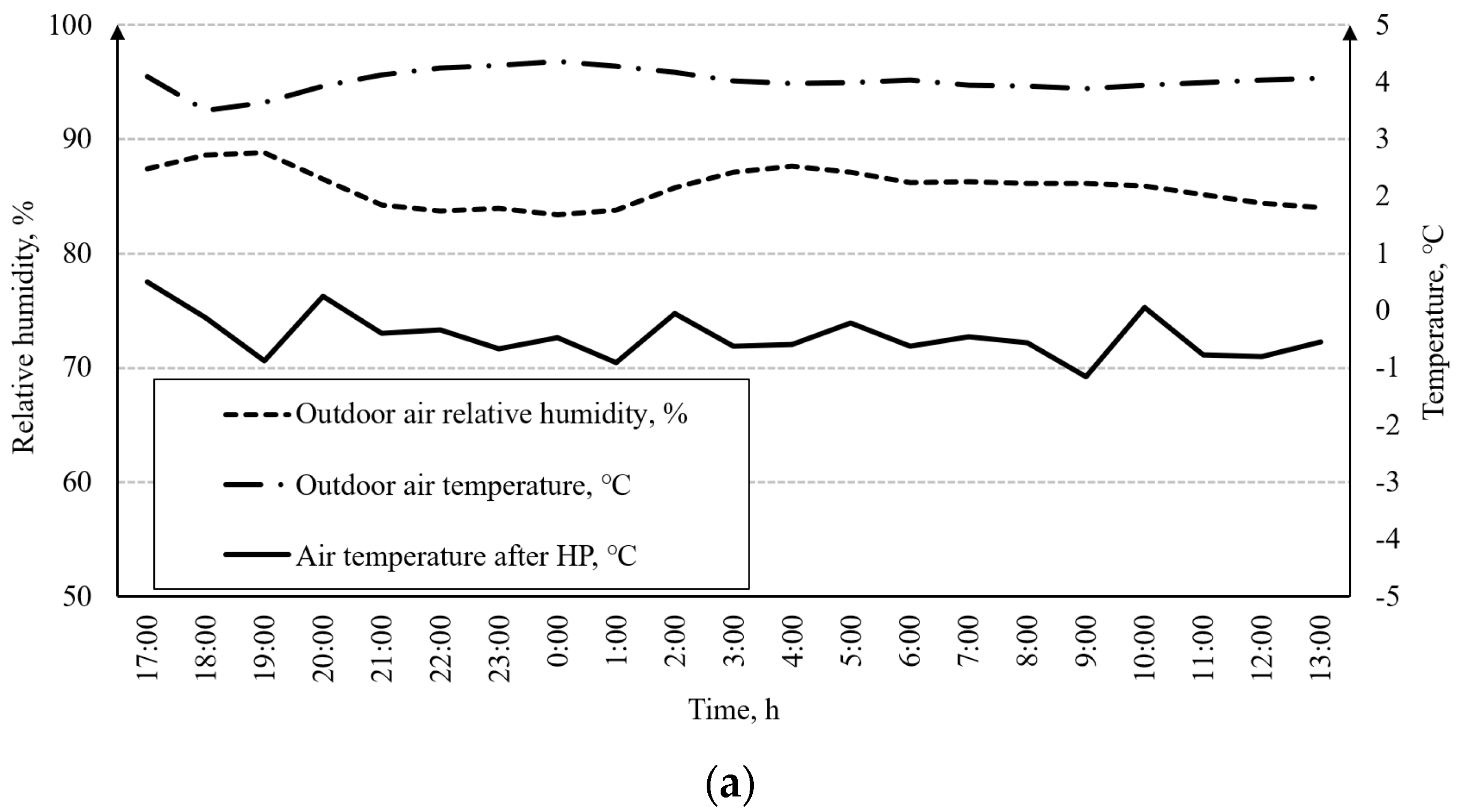
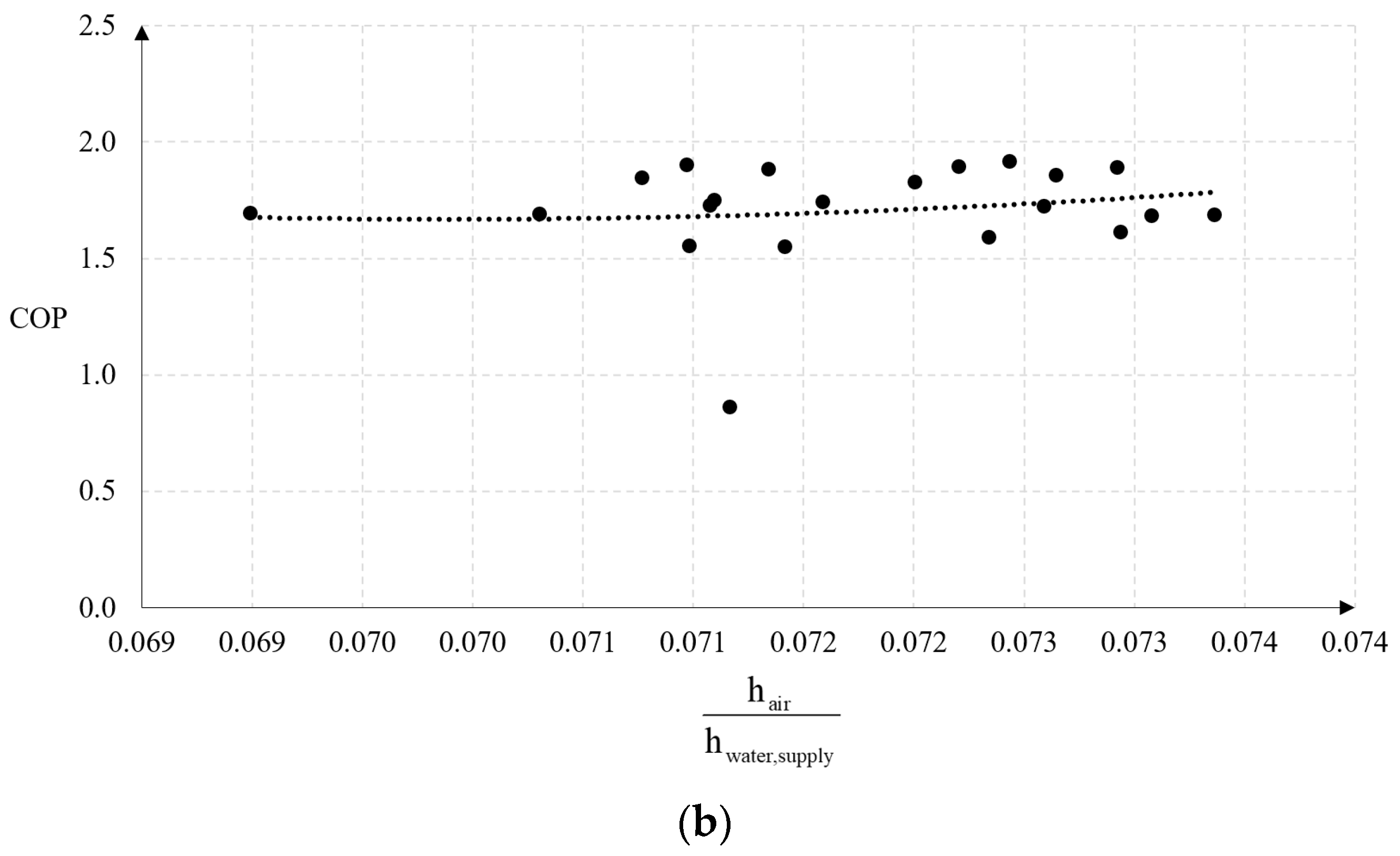
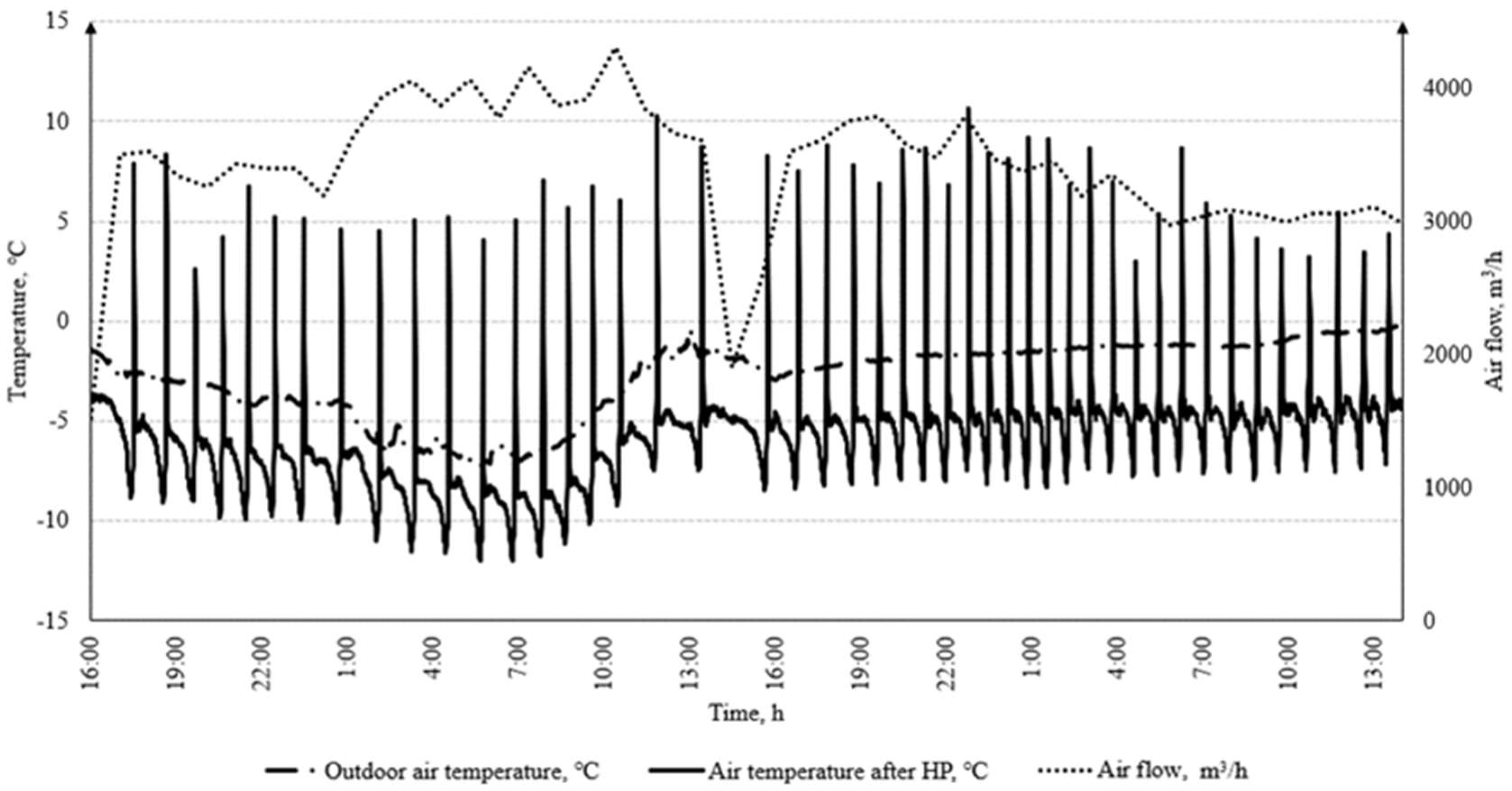
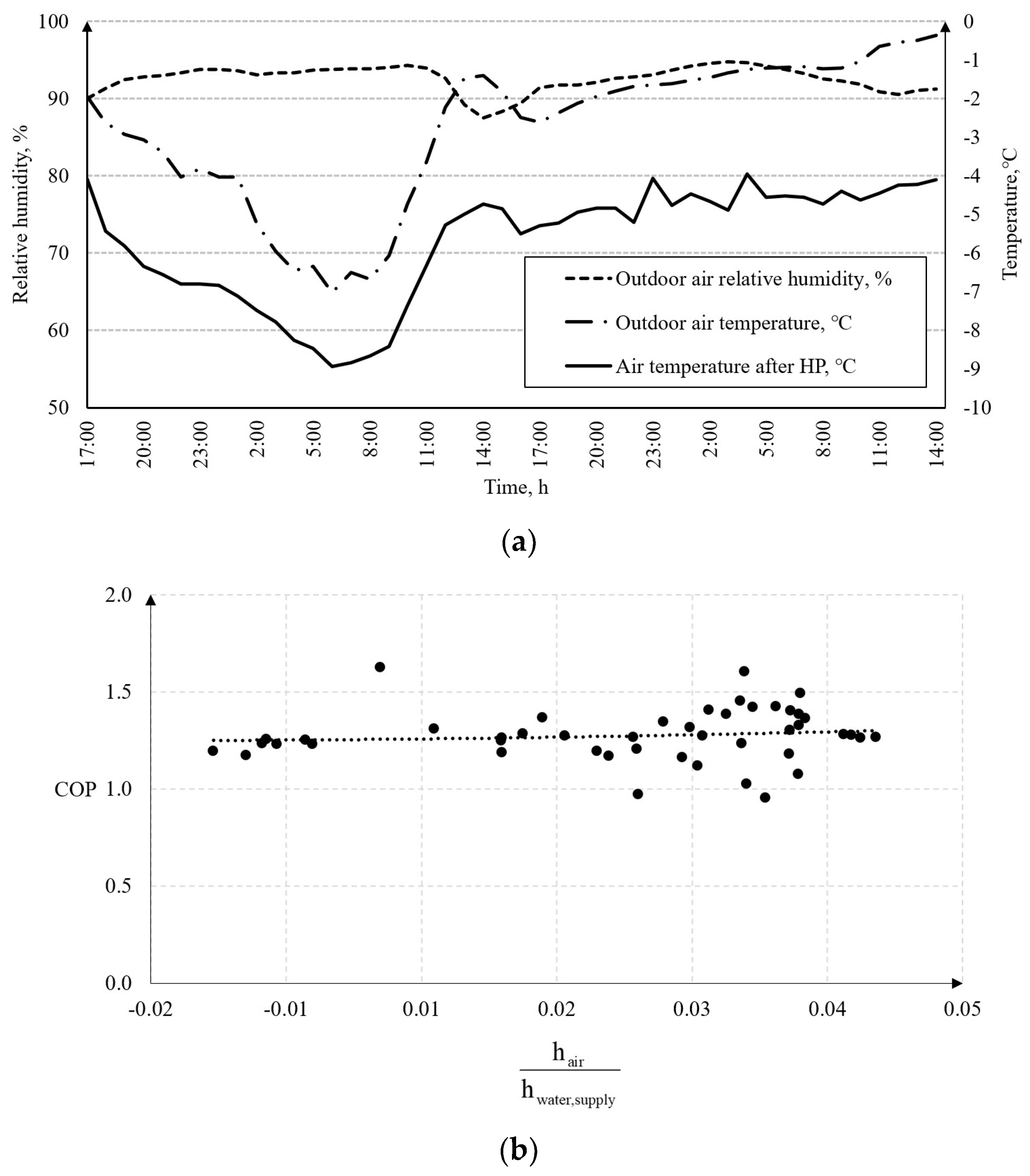

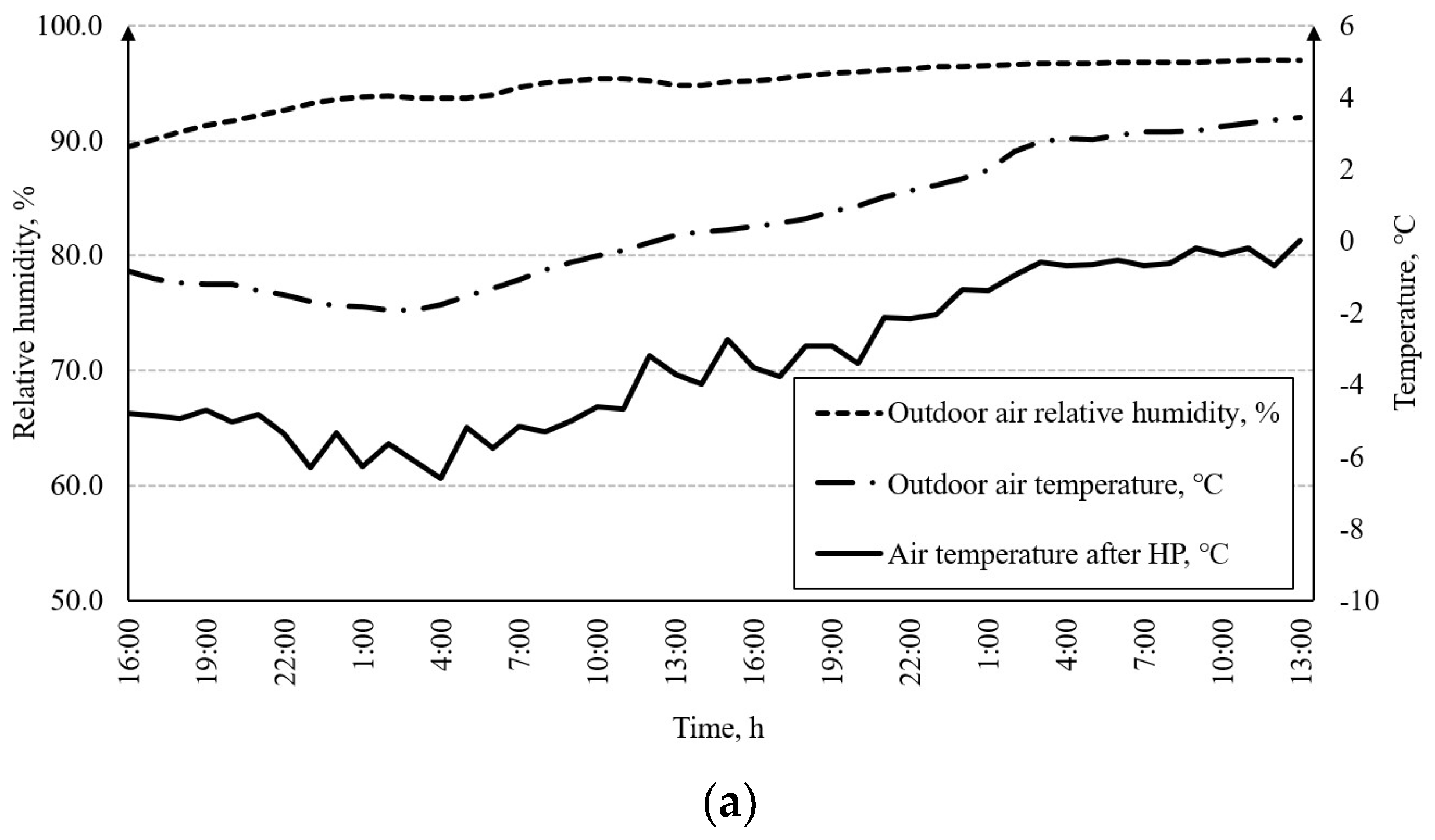

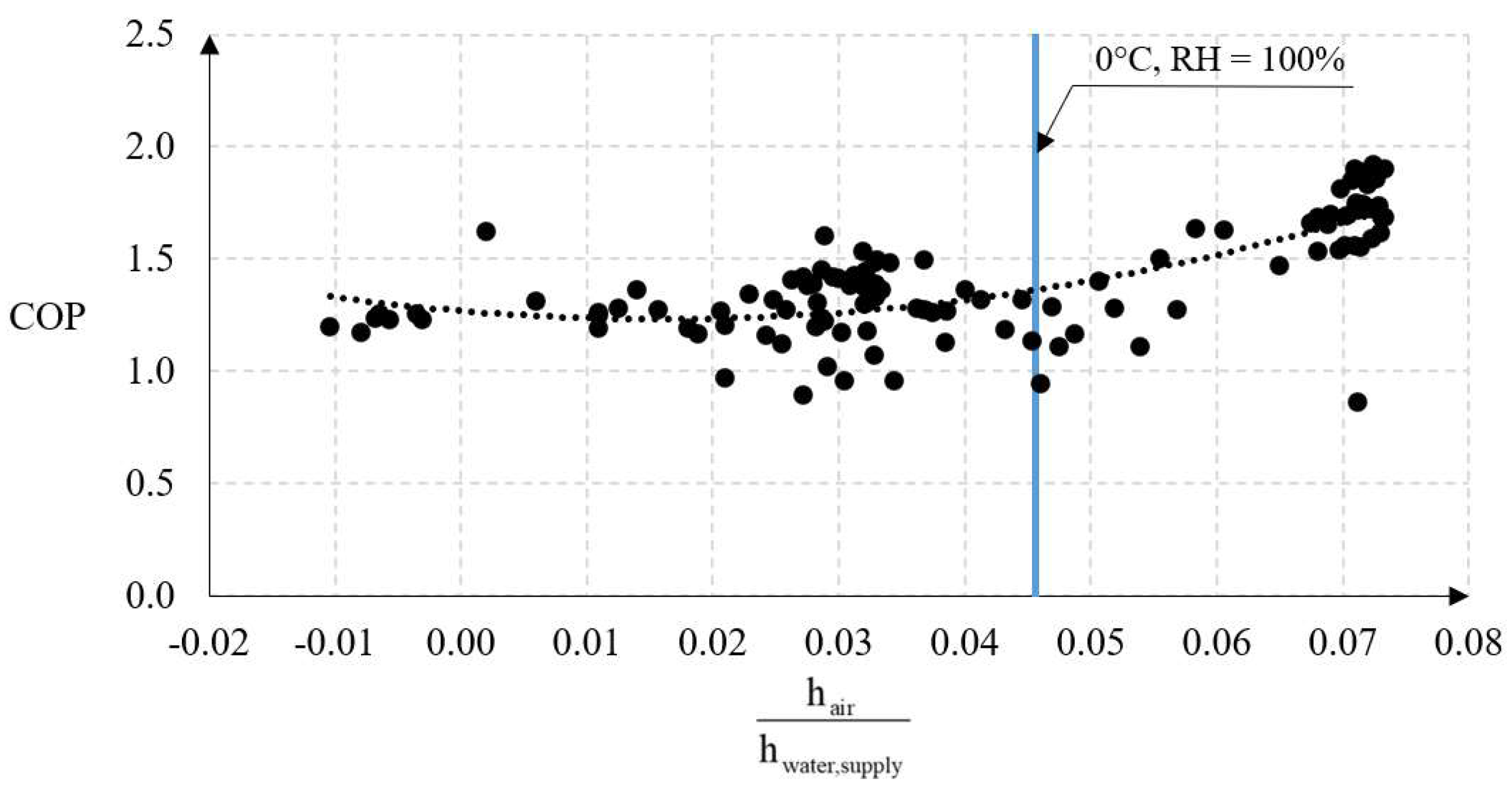
Publisher’s Note: MDPI stays neutral with regard to jurisdictional claims in published maps and institutional affiliations. |
© 2021 by the authors. Licensee MDPI, Basel, Switzerland. This article is an open access article distributed under the terms and conditions of the Creative Commons Attribution (CC BY) license (https://creativecommons.org/licenses/by/4.0/).
Share and Cite
Kropas, T.; Streckienė, G.; Bielskus, J. Experimental Investigation of Frost Formation Influence on an Air Source Heat Pump Evaporator. Energies 2021, 14, 5737. https://doi.org/10.3390/en14185737
Kropas T, Streckienė G, Bielskus J. Experimental Investigation of Frost Formation Influence on an Air Source Heat Pump Evaporator. Energies. 2021; 14(18):5737. https://doi.org/10.3390/en14185737
Chicago/Turabian StyleKropas, Tomas, Giedrė Streckienė, and Juozas Bielskus. 2021. "Experimental Investigation of Frost Formation Influence on an Air Source Heat Pump Evaporator" Energies 14, no. 18: 5737. https://doi.org/10.3390/en14185737
APA StyleKropas, T., Streckienė, G., & Bielskus, J. (2021). Experimental Investigation of Frost Formation Influence on an Air Source Heat Pump Evaporator. Energies, 14(18), 5737. https://doi.org/10.3390/en14185737








